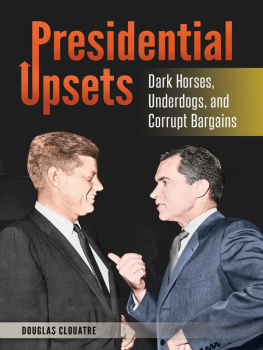Copyright 2005 by Facts That Matter, Inc.

CONTRIBUTING WRITERS:
David Aretha, Bill Chastain
Tim Knight, Sue Sveum

Warner Books, Inc.
Hachette Book Group
237 Park Avenue
New York, NY 10017
Visit our website at www.HachetteBookGroup.com
First eBook Edition: October 2009
ISBN: 978-0-446-55490-9

To Billy and Buster
and Broadway Joe
whom I think about every time
I want to do the impossible



I am very grateful to my contributing writers who so diligently helped me choose the events in this book and, of course, gave me some marvelous text to work with. They are, in alphabetical order: David Aretha, Bill Chastain, Tim Knight and Sue Sveum. Andy Horner also assisted in flushing out their text in spots, making it far better for telling the story. Sportswriter Marty Strasen, too, helped immeasurably.
Rick Wolff, my editor at Warner Books, proved to be one of my biggest assets and went far beyond his duties as my editor. His knowledge of sports and books is unequalled and his stamp on my book will always be appreciated. I am also grateful to Jamie Raab and Maureen Egen, who have looked at many of my projects through the years and eventually settled on this one as my first Warner book. Jason Pinter, also of Warner, could not have been more helpful and supportive. Flamur Tonuzi, ace designer of Warner, provided an exciting cover and was a joy to work with. So was Chris DuBois who tracked me halfway around the world to negotiate our contract.
Jim Lampley, thank you, for your wonderful reading of the script, and your expert consultation on it; and to Lou Oppenheim for putting us together. Other sports figures helped us rank the upsets including: Ross Greenburg of HBO, Jay Rizick and Crowley Sullivan of ESPN, Mark Mravic of Sports Illustrated, Jim Litke of the Associated Press, Mark Geddis of Collegiate Images, Steve Cangelosi of Topps Baseball Cards, Alex Sachere, formerly of the NBA, and many others.
I am also grateful to many who helped with our documentary including Louise Argianas of ABC-TV, Peter Bregman of Fox Movie Tone, Meredith Fox of the NBA, Peter Helfer of Major League Baseball, Greg Weitekamp of the NCAA and Tamera Reub of the United States Olympic Committee.
Our television crew who worked on the DVD documentary couldnt have been better, including Marcus Yasui, Mike Johnson, Toni Johnson, Pamela Lljubo and Peter Levermann. The post production folks too, including Jeff Pulera of Digital Vision and Jack Piantino of Creative Edge Video.
Help and support came from many others including: Nicole DiGiacomo and Andy Hill of AP Wide World Photos; John Kirchner of Datasis; Jack Huckel of the National Soccer Hall of Fame; Detlev Boschung of the Fdration Internationale de Football Association (FIFA); Tony Randolph, Chaminade Alumni; Mark Weinstein, and many others.
Thank you all! LES KRANTZ
H ow does a 45-to-one shot knock out the fiercest warrior to enter the boxing ring in 40 years? By what twist of fate can a bunch of college boys beat the greatest Olympic hockey team in history? What would allow a five-foot-eight-inch NBA midget to win a slam dunk tournament, humiliating even the seven-foot giants of the sport?
Things like this have puzzled me for most of my life. But they have also inspired me. Each time I hear of some underestimated athlete knocking off the competition, my skin breaks out in goose bumps.
Of course, from the fans standpoint, these things are only vicarious thrills, but thats not necessarily such a bad thing. Knowing full well that we may personally never be able to accomplish world-class athletic achievements, seemingly unrelated things can provide solace. Take that nerdy-looking geek with glasses who dropped out of college to become the greatest business success of the 20th century with his computer software company. And theres that soft-spoken, milk-toast intellectual who founded a girly magazine in the 1950s and even today gets those great-looking center-fold types to stop by his mansion for a little fun.
Unlikely achievers are part of the landscape of life, not just somebody or something that surfaces on the playing field. Regardless of what you do for a living, theres always the possibility you can triumph over the giants in your profession. Simply put, sometimes David does slay Goliath. Its literally been going on since Biblical days and has never stopped. In truth, every sports season theres a new dark horse or underdog to capture our imagination.
Please dont confuse the events in The Greatest Sports Upsets of All Time with the subject of my previous book, Not Till the Fat Lady Sings, which was about the greatest sports finishes. This one pertains to upsets, which means unexpected victories, though theres more to it.
The 50 upsets in this book were chosen by myself and my contributing writers. The most important factors in our choice were not only the unevenness of the match, but other things too, such as how unlikely the competitor. For example, we included Jim Abbott, a one-handed baseball pitcher and Ed Furgol, a physically challenged golfer. We also chose Kerri Strug and Tenley Albright, both Olympians who were seriously injured when they competed. Most fans would never expect disabled or injured athletes to beat the pants off the worlds best competitors who were in their best form, but they did. In sum, the 50 sports events we chose werent just the most uneven matches; the choices were tempered by an underdog factor, which made the victors triumph over the odds incredible.
Please also note that a few, and just a few, famously uneven match-ups werent included in this volume. We went for those which we considered to be the greatest sports upsets, since they were the best examples we could find of unanticipated and dramatic victories that defied almost all odds. Of course, any red-blooded sports fan might challenge the selection of these upsets. But in truth, thats the beauty of sports.
We also ranked the 50 major upsets. This was achieved by circulating ballots among sportswriters, sports broadcasters and various sports professionals. Their professional affiliations include the Associated Press, ESPN, HBO Sports, Sports Illustrated and other well-known organizations involved in sports. Each balloter assigned a one to five numerical score to each of the 50 events, and we then averaged the scores. There were several averaged scores that tied, but these ties were broken by a blue-ribbon panel, which reviewed them and adjusted the rankings based on their knowledge of the events.





















